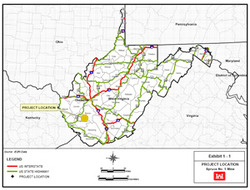EPA moves to veto massive mountaintop removal operation in West Virginia
 The Environmental Protection Agency has taken a step toward blocking a water pollution permit for a massive mountaintop removal mining operation in West Virginia.
The Environmental Protection Agency has taken a step toward blocking a water pollution permit for a massive mountaintop removal mining operation in West Virginia.Last week, EPA issued what's known as a "proposed determination" [pdf] for the Spruce No. 1 Mine. Located in Logan County, W.Va., it's one of the largest surface mining operations ever authorized in Appalachia.
The determination seeks public comment on the agency's intention to restrict the use of several streams to received the waste material from the mining operation under the Clean Water Act.
"Coal, and coal mining, is part of our nation's energy future, and for that reason EPA has made repeated efforts to foster dialogue and find a responsible path forward," said Shawn Garvin, administrator for EPA's Mid-Atlantic region. "But we must prevent the significant and irreversible damage that comes from mining pollution -- and the damage from this project would be irreversible."
The U.S. Army Corps of Engineers has authorized the Mingo Coal Co. -- a subsidiary of Arch Coal of St. Louis, the nation's second-largest coal producer -- to dump waste from the mining operation into Seng Camp Branch, Pigeonroost Branch, Oldhouse Branch and tributaries. As authorized, the project would directly impact more than 2,200 acres and seven miles of streams.
While acknowledging the project has already undergone extensive regulatory review, EPA does not want it to move forward:
EPA Region III is taking this action because it believes, despite all the regulatory processes intended to protect the environment, that construction of Spruce No. 1 Mine as authorized would destroy streams and habitat, cause significant degradation of on-site and downstream water quality, and could therefore result in unacceptable adverse impacts to wildlife and fishery resources.The determination goes on to note that the project may have cumulative adverse impacts along with other mining operations underway or proposed in the Coal River sub-basin, which is already heavily mined.
The EPA has exercised its veto power under the Clean Water Act in only 12 cases since 1972 -- and never for a previously permitted project.
The agency will be accepting public comment on the determination for 60 days and will also hold a hearing on the matter in West Virginia. But as Charleston Gazette reporter Ken Ward Jr. observes on his Coal Tattoo blog, this is only the beginning of what's expected to be a long process toward deciding whether the mining operation will ultimately be blocked.
Indeed, Arch Coal has said it plans to fight the decision. "We are evaluating all possible options for relief from the government's actions and intend to vigorously defend the Spruce permit by all legal means," it said in a statement.
For more EPA documents on the case, click here.
(Map showing location of Spruce No. 1 Mine from EPA's website.)
Tags
Sue Sturgis
Sue is the former editorial director of Facing South and the Institute for Southern Studies.
